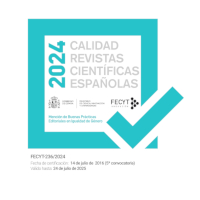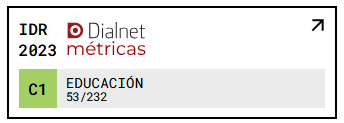Los contenidos temáticos y socioculturales de los manuales de F.L.E. para primaria
DOI:
https://doi.org/10.18172/con.584Keywords:
foreing language teaching, socio cultural aspect of language, course booksAbstract
As a consequence of the publication of the MER in 2001, the sociocultural aspect of foreign language learning and teaching takes added significance in new education laws. Bearing in mind the new objectives, this paper attemps to analyse the thematic and socio cultural contents of a number of F.F.L. texts for primary education, and specially three of them: Le Poisson d’avril, Menu cantine and La Famille de Théo. The evaluation of these teaching materials has been done taking into account that the that in this educational period, the word of the teacher is essential in order to update, specify, and integrate contents in the classroom.Downloads
References
Areizaga, E. (2002). El componente cultural en la enseñanza de lenguas: elementos para el análisis y la evaluación del material didáctico. Cultura y Educación, 14(2) 161-179.
Auger, N. (2003) Manuels et stéréotypes. Le Français dans le monde, nº 326.
Barret, P., Gurgand, J. N., Tiévant, Cl. (1980). Almanach de la mémoire et des coutumes. Paris: Hachette.
Candela, P. et al., (1997), La marelle, Français langue vivante. Barcelona: Coiné.
Conseil de l’Europe (2001). Cadre européen commun de référence pour les langues. Apprendre. Enseigner. Evaluer. Paris: Didier/Conseil de l’Europe.
Cuq, J. P. y Gruca, I. (2003). Cours de didactique du français langue étrangère et seconde. Grenoble: Presses Universitaires de Grenoble.
Juri, L. y Guiard, L. (2003). Carambole, Méthode de français, 1 y 2, Madrid: S.M.
Kramsch, C. (1988). The cultural Discourse of Foreing Language Textbooks. En A. J. Singerman, Toward a New Integration of Language and Culture (pp. 47-62). Middlebury. VT: Northeast Conference on the Teaching of Foreing Languages.
Le Hellaye, C. Barzotti, D. (1992-1993) Farandole 1 y 2, Méthode de français, París: Hatier: Didier.
Marco Común Europeo de referencia para las lenguas (MCERL): aprendizaje, enseñanza, evaluación (2002). Ministerio de Educación, Cultura y Deporte. Madrid: MECD y Grupo Anaya, p. 99.
Meyer-Dreux, S., Garabédian, M. y Lerasle, M. (1991). Trampoline, Méthode de français. Paris: Clé International.
Palomino, M. (2003). Mikado. Madrid: Oxford Educación.
Paccagnino, C. y Poletti, M. L. (1992). Kangourou, Méthode de français pour les enfants. Paris: Hachette.
Paricio Tato, M. S. (2005). La dimensión cultural en los libros de texto de lenguas extranjeras: pautas para su análisis. Glosas Didácticas, 15, 133-144.
Poirier, Cl. (avril 1970). Le mot de la semaine. Poisson d’avril. Chronique linguistique du TLFQ.1, 1. Extraído el 1 de abril, 2007 del sitio web de l’Université Laval de Québec (Canadá). http: www.tlfq.ulaval.ca/cours/chronique/chronique1.htm.
Rico Martín, A. (2004). De la competencia intercultural en la adquisición de una segunda lengua o lengua extranjera: conceptos, metodología y revisión de métodos. Porta Linguarum, 3, 79-94.
Transnational Framework for Inservice Courses (Trafic) (2004). Aprender a enseñar otro idioma en la escuela primaria. CILT.
Trujillo Sáez, F. (2005). En torno a la interculturalidad: reflexiones sobre cultura y comunicación para la didáctica de la lengua, Porta Linguarum, 4, 23-39.
Trujillo Sáez, F. (2006). La cultura en la enseñanza de idiomas: de la teoría a la práctica a través del PEL. Articles de Didáctica de la Llengua i de la Literatura, 39, 49-55.
Vez Jeremías, J. M. (2001). Formación en Didáctica de las Lenguas Extranjeras, Rosario: Homo Sapiens.
Vigotsky, L. (1991). El papel del juego en el desarrollo del niño. En El desarrollo de los procesos psicológicos superiores. Barcelona: Crítica.
http://www.edufle.net/breve67.html. Activités pédagogiques sur le thème du "poisson d’avril" (2004, abril 6) Origine et tradition. [Última consulta: 01/04/2007].
Downloads
Published
How to Cite
Issue
Section
License
The authors retain copyright of articles and authorize Contextos Educativos. Revista de Educación the first publication. They are free to share and redistribute the article without obtaining permission from the publisher as long as they give appropriate credit to the editor and the journal.
Self-archiving is allowed too. In fact, it is recommendable to deposit a PDF version of the paper in academic and/or institutional repositories.












